Keeping the Ladbroke area special

Pubs in the Ladbroke area
The Ladbroke estate has always been well-supplied with pubs. There are now nine in total; and in the past there were as many as sixteen. All are or were strung out along or just off the four main north-south arteries through the estate – Clarendon Road, Ladbroke Grove, Kensington Park Road and Portobello Road – no doubt deliberately sited to attract passing traffic.
When an area was being developed, a public house was often the first building to be put up on a corner site, after which the builder would add a terrace of houses next to it. For developers, a pub provided a handy place where his workmen could eat, drink and be paid – in the words of Mark Girouard in his excellent book Victorian Pubs, “a combined site office and canteen”. Often the developer or builder became the licensee, and no doubt was not unhappy to see the wages he had just paid his workmen flowing back into the tills of the pub. The pub would then usually be sold on – for instance, Paul Felthouse, the builder of the Warwick Castle (now The Castle) in Portobello Road, was the first licensee but then sold the pub a year or so later in 1853 for £3,000 to the brewer Sir Henry Meux.
Development on the Ladbroke estate proceeded by fits and starts, as developers regularly ran into various financial difficulties, and it was not unknown for pubs to stand in isolation for a number of years before the houses they were intended to serve came to be built. As the periodical The Builder of 25 February 1854 said: “On the pastures lately set out for building, you may see a double line of trenches with excavation either side … and a tavern of imposing elevation standing alone and quite complete, waiting the approaching rows of houses”. One such tavern was the Elgin in Ladbroke Grove. It was built just before the financial collapse in 1855 of the main developer of the area, Dr Samuel Walker, which brought all building to a halt for several years. In 1860 a press article described it as the only building “in a dreary waste of mud and stunted trees… with wind howling and vagrants prowling in the speculative warnings around them”.
Pubs obviously benefited from being next to a transport hub. The Elgin was the terminus for horse omnibus line; and the Kensington Park Hotel was right next to the new Ladbroke Grove station (then known as Notting Hill Station) on the Metropolitan line. Typically, pubs had a billiard room and a club room on the first floor, the latter available for hire. Some offered rooms – hence the inclusion of Hotel in their names.
Almost all our pubs were built within a space of some 30 years between 1840 and 1870. The Ladbroke estate was developed from south to north, so our oldest pubs are in the south. Oldest of all is probably the Prince Albert in Pembridge Road, which dates from 1841, the year after Queen Victoria’s marriage to Prince Albert of Saxe-Coburg-Gotha. It was the first building to be put up by William Chadwick, the developer to whom the Ladbroke family had entrusted the development of the area around the intersection of Kensington Park Road and Ladbroke Road, and he was also the first licensee.
The next oldest pub in our area is probably the Mitre in Holland Park Avenue, which dates back to the early 1840s, although it was rebuilt in the 1930s. The Ladbroke Arms is also an early pub, dating probably from the late 1840s or early 1850s. Clarendon Road was one of the first north-south roads to be developed and William Reynolds, one of the developers most involved, built a very grand pub at 85 Clarendon Road in 1846, the Clarendon Hotel. It sadly ceased operating as a pub in 1919 (it is now the Quest social centre), but remains one of the area’s most elegant buildings and has been given a Grade II listing.
The 1860s to 1870s saw a plethora of pubs opening in the more commercial areas of Ladbroke Grove, in Portobello Road and at the northern end of Kensington Park Road. The Clarendon Hotel may be a model of restrained elegance but, as the 19th century advanced, pub architecture became more and more florid and ornate, as can be seen in case of the Kensington Park Hotel. Some of the earlier pubs like the Elgin – which is now a treasure-trove of gold-engraved glass, crystal and ornate tiles – also gave themselves a makeover to keep up with the new fashion in pub decoration
Several of the pubs that opened in the 19th century have now disappeared. None of the pubs at the northern end of Kensington Park Road has survived. The Codrington on the corner of Elgin Crescent closed after the First World War and the building is now occupied by an estate agent, although its past as a pub can still be seen from the shape of the building. The charmingly-named Grasshopper in a pretty building at Nos. 216-218 Kensington Park Road closed around the same time. A pub called first the Arundel Arms and then the Blenheim Arms on the corner of Blenheim Crescent survived until fairly recently but is now the E&O restaurant.
The pubs in Portobello Road have until recently fared better. One pub – the Portobello Tavern on the corner of Lonsdale Road – closed many years ago. But in the part of Portobello Road that lies within the Ladbroke area, The Duke of Wellington, the Castle, Portobello Gold, Portobello Star and First Floor (formerly The Colville) are still in operation, although the Portobello Star in particular is now more of a cocktail bar than a traditional pub. Sadly, Shannons Market Bar (formerly the Golden Cross) has closed down and is reopening as a sushi restaurant.
The above is an extract from an article that appeared in the Spring/Summer 2015 edition of our newsletter, Ladbroke News.
Pubs still in operation
The Castle (formerly Warwick Castle)

The Castle in 2008
This pub at 225 Portobello Road (on a part of the road that before 1870 was called All Saints Terrace), on the corner of Westbourne Park Road, was renamed The Castle in 2002. It dates from 1853 and the solicitor and developer Thomas Pocock was probably responsible, the builder being Paul Felthouse. In her book Notting Hill in Bygone Days (not always 100% reliable), Florence Gladstone says:
‘The Warwick Castle at the corner of Cornwall Road [the then name of Westbourne Park Road] is the successor of a small inn of the same name; and opposite the inn, across Portobello Lane, was a cattle pond at the edge of a field.’
The builder of the pub, Paul Felthouse, seems either to have invested in the freehold or to have been given a 99-year lease of the pub so that he could recover his building costs. When it was first built, he made himself the licensee, but after a year sold the freehold or leasehold to the brewer Sir Henry Meaux, whose name can be seen on the old postcard below. According to the census, Felthouse was born in Warwickshire, which is probably why he chose the name Warwick Castle.

The Warwick Castle in around 1906 (courtesy RBKC).
The date can be ascertained from the advertisement for “the Brass Bottle” on the horse-bus, a show that opened in September 1906 at the Vaudeville Theatre.
Duke of Wellington

Duke of Wellington in 2019
This pub at 179 Portobello Road was probably built by Pocock in the 1850s or very early 1860s (it was in existence at the time of the 1863 Ordnance Survey mapping exercise).
The Duke of Wellington pub was the Portobello flagship of the H. H. Finch bar chain (taken over by Young’s in 1991), which included several branches in Notting Hill. The name FINCH can still be seen incised in the roof parapet.

Duke of Wellington in 2006

Duke of Wellintgton 1960s

Duke of Wellington (on left) c.1904
The Elgin

The Elgin in 2006
This pub is at 96 Ladbroke Grove on the corner of Blenheim Crescent. It was built in the mid-1850s, just as the area was beginning to be developed. It was originally the “Lord Elgin” or “Elgin Arms” (in 1863). It was remodelled in the late 1860s and is a fine Victorian pub. The building was given a Grade II listing in 1976. In the 19th century it was situated by a horse-omnibus terminus, so was well-situated to attract custom.
The Distillery

The newly decorated Distillery in 2016
This bar/restaurant/hotel at No. 186 Portobello Road (on the corner of Talbot Road) was formerly The Colville or Colville Hotel. It seems to have opened in the early to mid 1860s, as the West Middlesex Advertiser lists an outgoing licensee in 1867. Its history since has, to put it mildly, been chequered.
In the mid-20th century it was the Irish/West Indian local, known by many as the “Pisshouse”. After a spell as a bikers’ pub and the venue of the first Class War conference in 1983, the Colville was revamped as the Colville Rose and then the First Floor bar and restaurant (as in the photograph above). The First Floor closed in 2015. It was then taken over by the Ginstitute and given its present name, providing since late 2016 an experience in everything to do with gin, including its own distillery. The exterior has been splendidly redecorated. It had a handsome Victorian interior, which included a magnificent first floor restaurant room with a wonderful chandelier and Victorian mouldings, unfortunately destroyed when the Ginstitute took over. It has been used as a set for two films – London Kills Me (Hanish Kureshi 1991) and the unreleased Hippie Hippie Shake (2007).
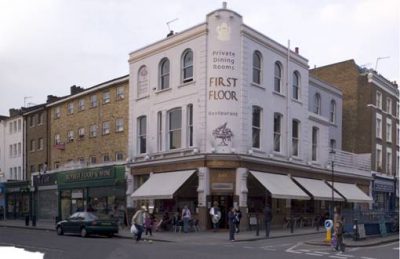
First Floor in 2006

The Colville in 1971
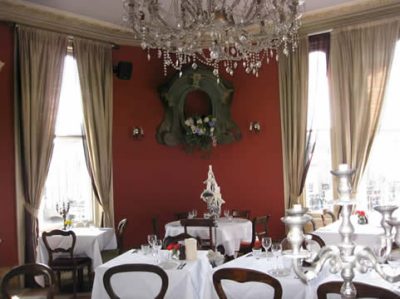
The first floor Victorian dining-room as it used to be.
Kensington Park Hotel

Kensington Park Hotel in 2015 (photoBecket)
This pub at 139 Ladbroke Grove dates from the 1860s – it was not built at the time of the 1863 Ordnance Survey mapping exercise, but is shown on an 1870 plan for the renumbering of Ladbroke Grove. Its opening was no doubt partly prompted by the opening of the station of the new Hammersmith and City Railway (now the Metropolitan Line). It has remained relatively unchanged since then, with red granite surround and stucco capitals. Until 1899 its address was 1 Ladbroke Grove Road.
The staircase rising from the ground floor bar once led to a luncheon room and billiard room, catering to young male workers. Originally a family concern, Canon Breweries took the pub over in the 1890s. The Labour politician Alan Johnson, in his memoir This Boy about his childhood in North Kensington, recalls that in the 1950s it was known for its fights which oftem spilled out onto the pavement. It was the Irish pub, and KPH was jokingly said to stand for “Keep Paddy Happy”.
A very good history of the Kensington Park Hotel was prepared in 2014 by KPH Ltd (a local community group established in 2014; its principal aim is to help preserve the use of the KPH as a public house).
Ladbroke Arms

The Ladbroke Arms in 2006
This pub at 54 Ladbroke Road (previously 2 Weller Road) opened in about 1850 and has flourished ever since. The first licensee appears from the directories as Mrs Mary Sawyer. In the 1851 census she describes herself as “laundress” and there were two bricklayers lodging with her, perhaps putting the finishing touches to her new pub. It is one of the smallest pubs in the area.
The Mitre
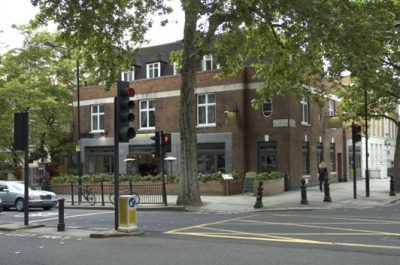
The Mitre in 2006
This pub at 40 Holland Park Avenue (originally 10 Notting Hill Terrace) is on the site of the original Notting Hill Farm. It seems from deeds in the possession of the owners that the pub was open at least by 1844, and possibly earlier. The present building is a replacement built between the world wars, nicely decorated with mitres on the roof parapet. It is not clear why it was called the Mitre; there are no obvious episcopal connections. In the 1980s, following the highly successful 1984 television series based on Paul Scott’s Raj Quartet, the pub was renamed by a new owner The Raj, and under yet another owner it became the Rat and Parrot, part of a chain of similarly named pubs. But neither incarnation was particularly successful, and the next owners returned the pub to its original name.
The main pub building was originally a bit further along Holland Park Avenue and there was a glass conservatory on the corner of Ladbroke Grove. In the 1850s the pub had stables and a coach house round the corner in Ladbroke Grove. Later the pub opened an off-licence on the Ladbroke Grove side, and the words OFF LICENCE can still be seen incised in the polished granite where it was (it closed when alcohol became readily available in supermarkets out of pub hours).
Portobello Gold (formerly the Princess Alexandra)

Portobello Gold in 2008
This pub at 95 Portobello Road began life as a beerhouse, selling beer for consumption on or off the premises. It was in existence by the time of the 1861 census (when the occupant of No. 15 Portobello Terrace as it was then was recorded as a beer retailer). In 1901 the beerhouse was recorded as being in the hands of 38-year-old Thomas Galworthy, and he and his family continued to run it for the next half century. It may have been named after Princess Alexandra of Denmark who married the future King Edward VII in 1863. It does not seem to have become a fully licensed pub until the Second World War.
The building in which the pub is situated had to be rebuilt in the 1920s because it was slipping down the hill (according to information in the landlord’s possession). The beerhouse was owned at the time by Truman’s Brewery, who purchased the neighbouring house at No. 97 and demolished and rebuilt that too. It occupies the site of both Nos. 95 and 97.
In the 1970s and early 1980s, the pub was much favoured by the Hell’s Angels. When it passed into new hands in the mid-1980s, it was renamed Portobello Gold and its character changed. It became more of a gastropub with a small hotel above.
The pub closed in the summer of 2017 and the lease was acquired by a new landlord. It has now been renovated and reopened in 2019 as “The Gold” as a restaurant plus bar. The new owners decorated the façade with a mural by the graffiti/street artist Alexandre Farto, who goes by the street name of Vhils. The mural was created by rendering over the whole of the front wall, then painting over parts of it while removing the render from other parts, exposing small glimpses of the brick beneath. The mural (see below) was strongly opposed by many local residents (and by the RBKC Planning Applications Committee), who thought it ugly and spooky, but it was allowed by the Planning Inspectorate on appeal. The Ladbroke Association was also unhappy, as it disfigures an interesting piece of 1920s pub architecture and will be difficult to remove without damaging the brickwork.

The mural by Alexandre Farto
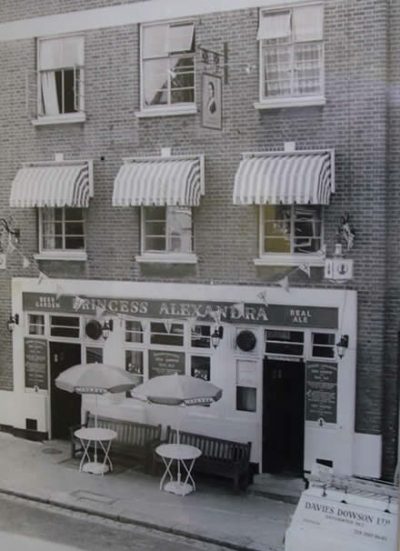
The Princess Alexandra in earlier times
Portobello Star

The Portobello Star in 2008
This bar at 171 Portobello Road was also originally a beer retailer rather than a fully licensed pub. The architect of the 1852-53 block in which it stands was Thomas Pocock. It was recorded as a beerhouse by 1870 (on the Portobello Road renumbering map). It seems to have become a fully licensed pub called the Portobello Star around the time of the Second World War. In 2011 it became the first home of the “Ginstitute” which made its own Portobello gin on the premises. The Ginstitute then moved to bigger premises at the old Colville at 186 Portobello Road, now called The Distillery and in 2017 the Portobello Star re-opened it as an “infusion bar” specialising in selling gin and other alcohols infused with various interesting flavours.
The Prince Albert

The Prince Albert pub at 11 Pembridge Road, with the Gate Theatre (the low rise part of the building on the left). Photo ©Thomas Erskine 2006.
This pub at 11 Pembridge Road is probably the Ladbroke area’s oldest pub. It was opened a year or so after Queen Victoria married Prince Albert in 1840. The builder was William Chadwick. The then owner of the Ladbroke Estate, James Weller Ladbroke, had signed an agreement in 1840 with Chadwick to develop the area at the intersection between Ladbroke Road and Kensington Park Road. As developers often did, he began by building a pub, where his workers could spend their wages to his benefit.
In the 19th century it was a hotel as well as a public house and the census returns show a number of barmaids and other servants resident on the premises. From the 1850s to the 1870s there was a brewery conveniently situated next door to the pub, possibly in the same ownership.
When the Chartist Leader Feargus O’Connor died in poverty in Notting Hill in 1855, the Kensington Gazette reported that “the friends and admirers of the deceased in his early political movements, mustered in strong force at the Prince Albert, Notting Hill, and followed the corpse two abreast to the cemetery [at Kensal Green] where an oration was delivered over the deceased’s body by a working man”.
In 1979 Lou Stein founded the Gate Theatre in an upstairs room at the Prince Albert. It is now one of London’s best known pub theatres, with a reputation for putting on interesting new or lesser known works.

The Prince Albert Hotel, probably around 1900. Above the door it says “LUNCHEON BAR”; and under the middle window there is a sign saying “WATER FOR HORSES.”
The left hand door offers “BILLIARDS.”
(Photograph by courtesy of RBKC.)
Other Portobello Road pubs

Sun in Splendour
There are two other pubs in the Portobello Road, outside the Ladbroke area:
Sun in Splendour at No. 7 Portobello Road, on the corner of Pembridge Road. This is the oldest of the Portobello pubs, dating from the late 1840s.
Earl of Lonsdale on the corner of Westbourne Grove.

Earl of Lonsdale
Former pubs
Arundel Arms (later Blenheim Arms)

This pub, which was at 14 Blenheim Crescent (on the north-east corner of Kensington Park Road), probably dates from the early 1860s – it appears in the 1863 Ordnance Survey map as the only completed building at this end of Blenheim Crescent. It started life as the Arundel Arms, perhaps because of the proximity of Arundel Gardens, but at some point changed its name to the Blenheim Arms. It closed around 2000, and is now a restaurant, although retaining its typical pub shape.
Clarendon Hotel

The old Clarendon Hotel at 85 Clarendon Road, on the corner of one of the spurs of Portland Road, is a most attractive building with magnificent Corinthian pilasters and tall Georgian-paned sash windows. It was been given a Grade II listing in 1976. It was completed around 1846 and the builder was probably William Reynolds. Reynolds established himself as the licensee and took out various mortgages on the building before going bankrupt in 1848. A mortgage that he took out in 1847 includes an extremely detailed and fascinating list of the fixtures and fittings in the establishment (see Survey of London, page 250, for a good summary). The building remained a public house and hotel, under a succession of different publicans, until 1919. In the 1920s it became the Quest Social Centre, which it remains to this day, providing day care for the elderly. It was nearly demolished in the 1970s to build modern housing, but was saved by being given its Grade II listing.
The Codrington

Early 1900s

This pub was at 17 Kensington Park Road, on the north-west corner of Elgin Crescent. It probably dates from the mid-1860s – it does not appear on the 1863 Ordnance Survey map but the West Middlesex Advertiser notes an outgoing licensee in 1867. It is now an estate agent, although like the Arundel/Blenheim Arms retains its recognisable pub form.
Golden Cross (later Shannon’s or the Market Bar)
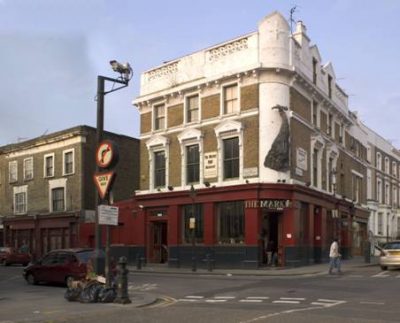
The Market Bar in 2006
This pub was on the corner of Lancaster Road and Portobello Road. Its address used to be 74 Lancaster Road, but it then changed to 240 or 240a Portobello Road. Again it probably dates from the 1860s – it appears as a public house on the 1870 Portobello renumbering map.
The Golden Cross was the scene of a fire in 1927 in which 4 people died. The funeral procession features in the first Portobello film by John Phibbs. The Golden Cross also appears as the Black Cross in the 1989 Martin Amis novel London Fields.
The pub was converted into the Market Bar, the first of London’s ‘new Bohemian bars’, and was closed in 2014. Irt reopened in 2015 as a sushi restaurant.
The Grasshopper

The Grasshopper at 216-218 Kensington Park Road probably dates from the later 1860s (it was not yet built at the time of the 1863 Ordnance Survey) and was probably built by Paul Felthouse, the builder of the Warwick Castle, as he appears as the licensee in the 1871 census. Unusually for what appears to be a purpose-built pub, it was not on a corner. It seems to have closed around the end of the First World War.
Portobello Tavern

The Portobello Tavern at 138 Portobello Road closed in the 1920s.
Other former Portobello Road pubs
Not all of the Portobello Road is in the Ladbroke area, and there are a number of pubs in other parts of the road that have also closed:
- Carnarvon Castle, on the corner of Golborne Road, which was reinvented in the 1990s as a gastropub called the Fat Badger, then a Moroccan-themed music joint called Bed Bar and since 2011 has been Pizza East.
- Duke of Sussex at No. 272 Portobello Road, on the corner of Acklam Road, which was demolished to make way for the construction of Westway in the 1960s.
- Freemasons’ Arms at No. 76 Portobello Road, which was destroyed by a bomb during the blitz.
- The Oxford at Nos. 90-92 Portobello Road, which closed in the 1930s. This pub was not purpose-built, but sometime between 1863 and 1871 a licensed victualler had set up at No. 92 (previously occupied by a grocer), and by 1891 the pub had expanded into the corner house at No. 90 as well. The name comes from the fact that the little terrace of buildings between Denbigh Close and Denbigh Terrace in which the pub stood was called Oxford Terrace before the renumbering of the Portobello Road in 1870.

